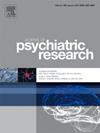单侧和双侧θ脉冲刺激治疗耐药抑郁症:自然观察研究的后续研究。
IF 3.7
2区 医学
Q1 PSYCHIATRY
引用次数: 0
摘要
目的:Theta 脉冲串刺激(TBS)是一种新颖、快速的经颅磁刺激方式,在治疗耐药抑郁症(TRD)方面前景看好。虽然 TBS 可单侧或双侧使用,但很少有研究在自然临床样本中比较这两种方法的有效性。在这项回顾性病历审查中,我们旨在(1)在一个中心的更大患者群中复制之前的双侧顺序 TBS 的有效性;(2)提供单侧和双侧 TBS 方法的治疗结果数据;(3)调查与我们观察到的结果相关的基线因素;以及(4)利用患者长达 6 个月的随访数据检查反应的持续性:我们纳入了 161 名接受 TBS 治疗的患者(单侧:n = 64(40%),45.55 ± 14.25 岁,55% 为女性;双侧:n = 97(60%),47.67 ± 15.11 岁,58% 为女性):首先,我们观察到双侧组的反应率为 47%,缓解率为 34%,这与我们小组的一项规模较小的自然研究结果相同;接受单侧 TBS 的患者反应率为 36%,缓解率为 26%,单侧和双侧 TBS 在缓解率和反应率方面没有显著差异。其次,与单侧刺激患者相比,双侧刺激患者所需的治疗次数更少(分别为平均 27 次和 29 次,t [159] = 3.31,p = .001),治疗后的焦虑症状(GAD-7)也明显低于单侧刺激患者,F (1,148) = 3.95,p = .049。第三,没有发现任何基线因素可以预测治疗结果。最后,6 个月后,69% 符合反应标准的患者不需要额外治疗或更换药物:我们的研究结果支持TBS对TRD的疗效和耐受性,并表明双侧TBS可能具有更优越的抗焦虑效果,且反应时间稍快。本文章由计算机程序翻译,如有差异,请以英文原文为准。
Unilateral and bilateral theta burst stimulation for treatment-resistant depression: Follow up on a naturalistic observation study
Objectives
Theta burst stimulation (TBS) is a novel and faster modality of transcranial magnetic stimulation, which is showing promise as a treatment-resistant depression (TRD) treatment. Though TBS can be applied unilaterally or bilaterally, few studies have compared the effectiveness of both approaches in a naturalistic clinical sample. In this retrospective chart review, we aimed to: (1) replicate previous bilateral sequential TBS effectiveness in a larger cohort of patients at a single centre, (2) present treatment outcome data between unilateral and bilateral TBS approaches, (3) investigate baseline factors associated with our observed outcomes, and (4) examine the sustainability of response, with follow-up data up to 6 months from patients.
Methods
We included 161 patients who received TBS (unilateral: n = 64 (40%), 45.55 ± 14.25 years old, 55% females; bilateral: n = 97 (60%), 47.67 ± 15.11 years old, 58% females).
Results
Firstly, we observed 47% response and 34% remission in the bilateral group, replicating findings from a smaller naturalistic study from our group; patients receiving unilateral TBS displayed 36% response and 26% remission, with no significant differences found between unilateral and bilateral TBS in remission and response rates. Secondly, bilaterally stimulated patients needed fewer treatments than those stimulated unilaterally (27 vs 29 on average respectively, t [159] = 3.31, p = .001), and had significantly lower anxiety symptoms post treatment (GAD-7) relative to patients receiving unilateral stimulation, F (1,148) = 3.95, p = .049. Thirdly, no baseline factors were found to predict treatment outcomes. Lastly, after six months, 69% of patients who met the response criteria did not require additional treatment or a change in medication.
Conclusions
Our findings support the efficacy and tolerability of TBS in TRD and indicate that bilateral TBS may have a superior anxiolytic effect and offer a slightly faster time to response.
求助全文
通过发布文献求助,成功后即可免费获取论文全文。
去求助
来源期刊

Journal of psychiatric research
医学-精神病学
CiteScore
7.30
自引率
2.10%
发文量
622
审稿时长
130 days
期刊介绍:
Founded in 1961 to report on the latest work in psychiatry and cognate disciplines, the Journal of Psychiatric Research is dedicated to innovative and timely studies of four important areas of research:
(1) clinical studies of all disciplines relating to psychiatric illness, as well as normal human behaviour, including biochemical, physiological, genetic, environmental, social, psychological and epidemiological factors;
(2) basic studies pertaining to psychiatry in such fields as neuropsychopharmacology, neuroendocrinology, electrophysiology, genetics, experimental psychology and epidemiology;
(3) the growing application of clinical laboratory techniques in psychiatry, including imagery and spectroscopy of the brain, molecular biology and computer sciences;
 求助内容:
求助内容: 应助结果提醒方式:
应助结果提醒方式:


